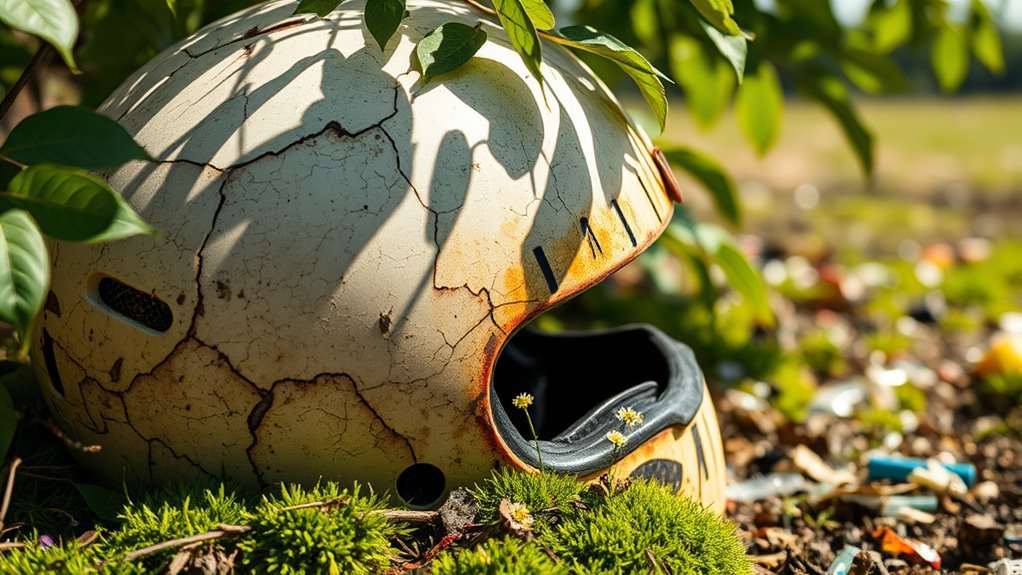The Environmental Impact of Helmet Materials
The materials used in helmet manufacturing have a significant environmental impact, affecting everything from production to disposal. Plastics contribute to long-lasting pollution and greenhouse gas emissions. While traditional materials often leave a hefty ecological footprint, innovations like biodegradable foams and recycled components are emerging. Sustainability in helmet design is becoming essential, as manufacturers explore eco-friendly alternatives and responsible disposal methods. You’ll find interesting insights into how these changes shape both safety and environmental consciousness.
Common Materials Used in Helmet Manufacturing

When it comes to helmet manufacturing, the choice of materials plays an essential role in both safety and environmental impact. You’ll often find carbon fiber and composite materials at the forefront. Carbon fiber offers lightweight strength and exceptional energy absorption, which enhances safety without compromising comfort. Its high durability means longer-lasting products, but it also raises questions about recyclability. On the other hand, composite materials blend various substances, providing a balance of flexibility and sturdiness. They can be more environmentally friendly if sourced responsibly. However, the environmental implications of these materials depend on their lifecycle—from production to disposal. Understanding these factors helps you make informed choices about your helmet, aligning safety with the values of freedom and sustainability.
The Environmental Footprint of Plastics

Although plastics are widely utilized in helmet manufacturing for their light weight and cost-effectiveness, their environmental footprint is significant and often troubling. The pervasive issue of plastic pollution stems from the non-biodegradable nature of these materials, which can linger in ecosystems for centuries. You might consider the importance of sustainable sourcing in reducing this impact.
| Impact Type | Description |
|---|---|
| Production Emissions | High levels of greenhouse gases |
| Waste Accumulation | Long-lasting pollution in landfills |
| Resource Extraction | Depletion of fossil fuels |
| Recycling Challenges | Low rates of effective recycling |
Choosing helmets made from responsibly sourced materials can mitigate some of these concerns, leading to a more sustainable future.
The Role of Foams in Helmet Safety

When it comes to helmet safety, the type of foam used plays a vital role in impact absorption. Different foams, such as expanded polystyrene and multi-density options, vary in their properties and effectiveness during collisions. However, it’s essential to take into account not just their safety performance, but also the environmental impact associated with their production and disposal.
Foam Types and Properties
While helmets are primarily designed for impact protection, the type of foam used in their construction plays an important role in ensuring safety. Open cell foams offer excellent breathability and comfort, making them ideal for extended wear. However, they tend to absorb moisture, which can compromise their structural integrity over time. On the other hand, closed cell foams are more rigid and resistant to water, providing better durability and maintaining their protective qualities. This distinction is vital for helmet manufacturers, as choosing the right foam type directly affects the balance between comfort and safety. Ultimately, understanding these foam properties empowers consumers to make informed choices about the helmets they trust for their protection.
Impact Absorption Mechanisms
The effectiveness of helmet safety largely hinges on how well the materials used can absorb and dissipate energy during an impact. In this situation, foams play an essential role in managing impact dynamics. By compressing upon impact, these materials convert kinetic energy into heat, greatly reducing the force transmitted to your head. Different foam types—like expanded polystyrene and multi-density foams—vary in their energy absorption capabilities, affecting overall helmet performance. The selection of foam directly influences how well a helmet can protect you in high-risk situations, ensuring that energy absorption is maximized. Understanding these mechanisms can empower you to choose a helmet designed for peak safety, enhancing your freedom to enjoy activities while minimizing risks.
Environmental Considerations in Production
As you consider the safety of helmets, it’s important to also examine the environmental impact of the materials used, particularly foams. These foams, essential for impact absorption, often come from petroleum-based sources, which raise concerns about sustainability. Emphasizing sustainable sourcing can lead to alternatives that reduce environmental harm while maintaining safety standards. Biodegradable or plant-based foams are emerging, but their performance and cost-effectiveness must be carefully evaluated. Additionally, materials recycling plays a critical role in minimizing waste. By promoting recycling initiatives, we can transform old helmets into new products, reducing the demand for virgin materials. Balancing safety and environmental responsibility is key when selecting helmet foams that reflect your values and commitment to a sustainable future.
Biodegradable Alternatives to Traditional Materials
Although traditional helmet materials like polycarbonate and expanded polystyrene offer durability and impact resistance, their environmental footprint raises considerable concerns. You might want to contemplate biodegradable alternatives such as bio-based composites, which utilize renewable resources and can greatly reduce reliance on fossil fuels. These materials not only provide adequate protection but also break down more easily in natural environments, minimizing long-term waste. Sustainable sourcing of these composites guarantees that the impact on ecosystems is lessened, aligning with a more environmentally friendly ethos. As awareness grows, manufacturers are increasingly exploring these options, giving you the freedom to choose helmets that reflect your values. By opting for biodegradable materials, you’re not just protecting yourself; you’re also contributing to a healthier planet.
The Lifecycle of a Helmet: From Production to Disposal
When you consider the lifecycle of a helmet, it’s essential to examine how raw materials are sourced and the environmental impact of the manufacturing process. Each stage, from extraction to production, contributes to carbon emissions and resource depletion. Finally, the methods used for disposal greatly affect the overall ecological footprint, highlighting the need for sustainable practices throughout the helmet’s lifecycle.
Raw Material Sourcing
Raw material sourcing plays an essential role in the environmental impact of helmet production, since the choice of materials directly affects both sustainability and carbon footprint. When you opt for helmets made from sustainably sourced materials, you’re not just protecting your head; you’re making a statement about environmental responsibility. Traditional materials, like petroleum-based plastics, often have high carbon emissions linked to their extraction and processing. In contrast, alternatives like bio-based plastics or recycled materials can greatly lower your ecological footprint. It’s vital to reflect on how these choices affect the entire lifecycle of the helmet. By prioritizing sustainable sourcing, you contribute to a more responsible production system, ultimately leading to a healthier planet for future generations. Choose wisely—your decisions matter.
Manufacturing Process Impact
The manufacturing process of helmets considerably influences their environmental impact, impacting everything from energy consumption to waste generation. When you consider how helmets are produced, you should pay attention to these key factors:
- Energy Consumption: The energy required for production can greatly contribute to greenhouse gas emissions, depending on the energy sources used.
- Manufacturing Emissions: The process generates pollutants that can harm air quality and contribute to climate change.
- Waste Generation: Excess materials and byproducts from production add to landfill waste, affecting the ecosystem.
End-of-Life Disposal Methods
Although many riders may overlook the end-of-life phase of helmets, understanding disposal methods is crucial for evaluating their overall environmental impact. When a helmet reaches its final days, improper disposal can contribute considerably to waste. Implementing recycling programs specifically designed for helmet materials can mitigate this issue. Many manufacturers now partner with waste management services to guarantee helmets are processed responsibly, reducing landfill contributions. By participating in these programs, you can help reclaim valuable materials like plastics and foams, promoting a circular economy. Consider checking if local retailers or manufacturers offer take-back initiatives. Your choice to dispose of helmets sustainably not only reflects personal responsibility but also contributes to a larger movement towards environmental consciousness.
Innovations in Eco-Friendly Helmet Design
As manufacturers endeavor to reduce their environmental footprint, innovations in eco-friendly helmet design are emerging as an essential component in promoting sustainability in the cycling and sports industries. You’ll find that these advancements primarily focus on:
- Sustainable Materials: Many helmets now utilize biodegradable plastics and recycled materials, greatly diminishing waste.
- Innovative Designs: Streamlined shapes and modular components not only enhance safety but also allow for easier disassembly and recycling.
- Low-Impact Production: Techniques that minimize energy consumption during manufacturing are becoming commonplace, ensuring that your gear is as green as it is safe.
Frequently Asked Questions
How Do Helmet Materials Affect Recycling Processes?
Helmet materials can greatly impact recycling processes due to recycling challenges and material compatibility. When materials like polycarbonate and EPS foam are mixed, they complicate sorting, leading to inefficient recycling. If you’re aiming for a sustainable approach, choosing helmets made from compatible materials can enhance recyclability. This not only reduces waste but also promotes a circular economy, allowing you to enjoy freedom in your choices while supporting environmental sustainability.
What Is the Carbon Footprint of Helmet Production?
The carbon footprint of helmet production varies considerably based on the materials and production methods used. Typically, manufacturing processes emit substantial carbon emissions, especially when plastics and synthetic materials are involved. For instance, traditional methods may release more greenhouse gases compared to innovative, eco-friendly alternatives. By choosing helmets made from sustainable materials and employing cleaner production techniques, you can help reduce their overall carbon footprint, contributing to a more eco-conscious lifestyle.
Are There Certifications for Eco-Friendly Helmets?
Yes, you’ve got options! Eco certifications like the Green Product Mark and Cradle to Cradle signify sustainable helmets. These accolades assure you that the materials used are environmentally friendly and responsibly sourced. When considering your choices, look for brands boasting these badges. By opting for eco-certified helmets, you’re not just protecting your head; you’re also promoting planet-friendly practices. So, go for sustainable options and ride with responsibility!
How Can Consumers Choose Sustainable Helmet Options?
To choose sustainable helmet options, look for those made from sustainable materials like recycled plastics or natural fibers. Research eco-friendly brands that prioritize environmental responsibility in their manufacturing processes. Check for certifications indicating adherence to sustainability standards. Reading reviews can also help you gauge the brand’s commitment to eco-conscious practices. By making informed choices, you support a market that values both safety and the planet, allowing you to ride with confidence and freedom.
What Are the Health Impacts of Helmet Materials?
Imagine donning a helmet that feels like a knight’s armor, but what lies beneath could be harmful. Some helmet materials contain toxic substances, which may pose health risks over time. Long-term exposure can lead to respiratory issues or skin irritations, undermining your freedom to ride safely. Choosing helmets made from safer, non-toxic materials can protect your health while ensuring you enjoy your adventures without the burden of hidden dangers.





